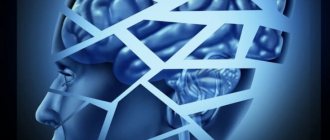Vegetative-vascular dystonia is one of the most mysterious diseases. Firstly, it is functional in nature - in other words, certain functions in the body are disrupted, while there are no visible changes in the organs. They cannot be detected during radiography, ultrasound, CT, MRI and other imaging methods, at the cellular level under a microscope. It is believed that VSD is associated with changes that occur at the subcellular level, and they can only be detected using electron microscopy.
Our expert in this field:
Serebryansky Yuri Evstafievich
Cardiologist, geriatrician, therapist, professor, Honored Doctor of the Russian Federation, Doctor of Medical Sciences
Call the doctor Reviews about the doctor
Secondly, in different sources, vegetative-vascular dystonia can be described as an independent disease, or as a syndrome - a set of specific symptoms. They can occur with arterial hypertension, diseases of internal organs, or exposure to ultra-high frequency electric currents on the body.
Thirdly, it is difficult to find a second such disease that has so many different names. VSD is often called neurocirculatory dystonia, neurocirculatory asthenia, cardioneurosis. It is believed that vegetative-vascular dystonia is closely related to such pathology as panic attacks.
Sometimes the term “Da Costa syndrome” is used as a synonym for VSD (other names are frenocardia, “irritable heart”, “soldier’s heart syndrome”). This pathology was first observed by J.M. Da Costa in young soldiers who participated in the American Civil War. They experienced shortness of breath, a feeling of lack of air, increased heartbeat, heaviness, and pain in the heart area.
Some interesting facts about VSD:
- Vegetative-vascular dystonia is a very common disease. It accounts for up to 50% of all pathologies of the heart and blood vessels.
- Women get sick more often than men.
- Most often, the first manifestations of vegetative-vascular dystonia occur at a young age.
- The development of VSD is based on disruption of the autonomic nervous system - it regulates the functions of internal organs, heart, and blood vessels.
- With VSD, functional disorders occur in all organs and systems, primarily in the cardiovascular.
Treatment of vegetative-vascular dystonia
Treatment of VSD is carried out in three main areas:
- combating the cause of the disease;
- impact on pathological processes that occur in the body;
- general strengthening activities.
There are many causes of vegetative-vascular dystonia, and they are not fully understood, so it is quite difficult to influence them. It is important to lead a healthy lifestyle. You need to eat well, get enough sleep, be in the fresh air, and avoid stress. Sometimes, with mild forms of the disease, this is enough - no other treatment for VSD is needed. Many patients benefit from psychotherapy.
In order to influence the pathological processes that occur in the body during VSD, the doctor can prescribe sedatives (motherwort, valerian), tranquilizers (help cope with fear, anxiety, emotional stress), antidepressants (help fight depression, anxiety), β-blockers (drugs that help reduce the activity of the “stress” part of the autonomic nervous system, cope with increased heartbeat, pain and discomfort in the heart area).
Symptoms of VSD in adults, as well as in children, are very insidious, for the following reasons:
- There are a large number of manifestations of vegetative-vascular dystonia; in different patients they are combined differently, each of them can be strongly or weakly expressed.
- Often the symptoms of vegetative-vascular dystonia resemble other diseases, usually of the cardiovascular system.
- Usually the patient makes many complaints, and during examination and examination no abnormalities are revealed.
Correctly assessing the signs of vegetative-vascular dystonia and establishing the correct diagnosis, not to miss another, more serious disease, will only help with a full, careful examination by a neurologist, a comprehensive examination.
Vegetative-vascular dystonia in adolescents and children
The disorder can occur already in early childhood, which is important to take into account for parents who send their child to kindergarten or notice changes in the teenager’s behavior. The first symptoms may appear when the child goes to kindergarten or finds himself in a stressful situation.
“There are times when a child feels uncomfortable in kindergarten,” explains neurologist Olesya Bryukhanova. “And as a defensive reaction, his temperature rises or vomits. These symptoms develop only in kindergarten, while at home the child feels well and has no signs of acute respiratory viral infection or intestinal disorder.”
Temperature during VSD is not the only sign of a child’s disturbed condition. Such children, as a rule, are capricious, do not want to go to kindergarten, often get sick and often come into conflict with other children. They have noticeable mood swings, and they tolerate any stress, be it physical or intellectual, worse than their peers.
In adolescence, hormones come into play, the need for self-affirmation in a team, and constant comparisons of oneself with others. When these comparisons are not in your favor or conflicts regularly arise with peers and parents, the load on the nervous system increases. The psyche becomes unstable, which is manifested in girls’ behavior by tearfulness, nervousness, and rudeness towards parents and teachers. In boys, there are outbursts of anger and pronounced negativity towards everything that surrounds the teenager. And if a teenager cannot show aggression openly, another extreme occurs - panic attacks, which are no less difficult to experience.
This behavior is often attributed to hormonal surges and age-related characteristics. But it's important to understand that hormonal changes don't have to manifest themselves this way. Moreover, they are more likely to create the ground for the development of the disorder, and the parents’ task is to see the problem in time. If a teenager has become emotionally unstable, his behavior has changed, he blushes and turns pale easily, experiences hot flashes and sweats a lot, and has blood pressure surges, you cannot expect this to go away on its own. In this case, characteristic symptoms of a nervous system disorder appear, which can and must be stopped at the very beginning of development.
“In my practice, there was a case when a 17-year-old boy suffered from high blood pressure,” comments neurologist Olesya Bryukhanova. “He was registered with a cardiologist, but the cause of arterial hypertension remained unclear for a long time. In the process of communicating with the patient, it became clear that he felt anger towards his parents. And since he had to constantly restrain his emotions and endure this internal conflict, he developed a syndrome. When we eliminated the psychological problem, both the blood pressure and the patient’s well-being returned to normal.”
Symptoms of VSD: what types of disorders occur with this disease?
Symptoms of VSD in adults and children are combined into several groups - syndromes :
- Cardiac syndrome – pain in the heart area.
- Tachycardial syndrome - increased heart rate.
- Hyperkinetic syndrome - inadequate strengthening, activation of the heart.
- Asthenic syndrome – chronic fatigue, fatigue, frequent mood swings.
- Autonomic dystonia syndrome is a disorder of autonomic functions (impaired functioning of the cardiovascular system, internal organs, glands).
- Respiratory distress syndrome is a dysfunction of the respiratory system.
This division of signs of vegetative-vascular dystonia is conditional.
Clinical manifestations
The signs and symptoms of vegetative-vascular dystonia in a child and an adult are the same. However, in each person the pathology occurs differently, which is influenced by the predominance of a certain part of the ANS and the type of neurocirculatory dystonia. For some, headaches predominate; for others, dizziness occurs when the ambient temperature changes. Fainting is possible, but after being brought to consciousness the person experiences relief and relaxation.
Vegetative-vascular dystonia is often accompanied by nausea and a feeling of the presence of a foreign object in the throat. Taking into account blood pressure indicators, the following types of VSD are distinguished:
- hypertensive: blood pressure increases;
- hypotonic: blood pressure decreases;
- mixed: jumps in indicators are observed.
Each type of VSD is characterized by its own symptoms.
Hypertensive type
Pathology of the hypertensive type occurs with the following clinical manifestations:
- increased blood pressure;
- headache and cramps;
- dizziness;
- weather dependence with increased severity of headaches, increased blood pressure;
- increased heart rate;
- impaired thermoregulation;
- weakening of intestinal motility, constipation;
- decreased production of tear fluid.
With VSD of the hypertensive type, a person quickly gets tired, even with light physical exertion.
Hypotonic
Vegetovascular dystonia of the hypotonic type occurs with the following symptoms:
- decreased blood pressure;
- rare pulse (bradycardia) or increased heart rate (tachycardia);
- pain syndrome in the heart (cardialgia);
- dizziness;
- frequent fainting conditions;
- headache, the intensity of which increases depending on weather conditions, during physical and mental stress;
- increased fatigue;
- biliary dyskinesia;
- digestive dysfunction;
- violation of thermoregulation;
- feeling of lack of air;
- paleness of the skin;
- increased cold sweating;
- symptoms of epilepsy - episyndrome, which is expressed in mild convulsive seizures.
With VSD of the hypotonic type, the risk of developing allergic reactions increases.
Mixed
In the absence of agreement between the structures of the ANS (sympathetic and parasympathetic divisions), various symptomatic manifestations arise. For example, when blood pressure jumps, redness of the face is observed or, conversely, paleness of the skin.
With VSD of mixed type, the clinical picture of the pathology combines symptoms characteristic of the other two types. Which department of the ANS will prevail in a certain period, such manifestations will be inherent in the human condition.
Vegetative crisis
With a severe course of vegetative-vascular dystonia, a crisis may occur - a condition characterized by the maximum severity of symptoms. It could be:
- increased sweating;
- severe nausea and headache;
- sudden illness;
- the appearance of a veil before the eyes;
- a pronounced decrease or increase in blood pressure;
- slowing heart rate.
After a crisis, a person’s condition does not recover immediately: for the next 2-3 days he will feel unwell, weak, and periodically dizzy.
What are the most common symptoms of vegetative-vascular dystonia?
Among the fair sex, the disease is more common, but the symptoms of VSD in women and men differ little. Most often, the disease has the following manifestations:
- Heartache . With vegetative-vascular dystonia, they can be different: stitching, aching, bursting, burning. Sometimes they last literally one moment (“the heart stabbed”), and in other cases they last for hours, days. Usually pain is provoked by overwork, weather changes, nervous tension, and alcohol consumption.
- Anxiety, worsening mood, weakness, restlessness are symptoms that often accompany heart pain. If the pain attack is severe, fear, increased heart rate, and a feeling of lack of air occur.
- Shortness of breath . Typically, patients with vegetative-vascular dystonia complain to a neurologist that they are worried about “shortness of breath,” but in fact, by this word they mean frequent shallow breathing. There is a feeling as if breathing is difficult, you want to take a deep breath.
- Feeling of a lump in the throat . This symptom is quite painful; a person feels as if “something is squeezing his throat,” and he is bothered by dizziness, weakness, anxiety, and fear of death. I want to open the window wider and go outside.
- Unpleasant sensations in the heart . This may be a feeling of increased heartbeat, as if the heart is “jumping out” or “turning over.”
- Weakness . Characteristic signs of vegetative-vascular dystonia: constant fatigue, drowsiness, low mood, decreased performance.
- Vascular disorders . Many patients with VSD note fluctuations in blood pressure. Headaches, dizziness, coldness, chilliness in the arms and legs occur.
- Feeling unwell when the temperature in the room or outside is high or low.
- Decreased performance . Both mental and physical. The patient gets tired quickly.
- Disorders of the digestive system . Symptoms of vegetative-vascular dystonia include nausea and vomiting, belching, hiccups, and abdominal pain. Appetite may worsen, causing the patient to lose weight.
VSD can begin in different ways. In some cases, all the symptoms appear at once, they are very pronounced. They can also grow gradually - a person even finds it difficult to say exactly when he realized that he was sick.
Main symptoms and signs
The manifestations of VSD are diverse; the general list includes over several dozen items, but patients experience only a few of them (usually from 5 to 20) in different combinations. An important point: with VSD, there is a combination of several symptoms that appear simultaneously, but in the complete absence of organic disorders. A separate manifestation of any of these signs is not a reason for diagnosing vegetative-vascular dystonia, since it usually indicates a specific pathology.
Doctors distinguish several forms of VSD, classifying them on the basis of identifying relatively typical sets of symptoms that resemble the course of certain pathologies of organs or systems.
Respiratory form of VSD
Respiratory vegetative-vascular dystonia is the most common. The patient complains of the inability to take a deep breath, is afraid of suffocating, gasps for air, feels soreness, tightness in the throat, heaviness or pain in the chest, and coughs frequently.
Tachycardial form
Complaints of rapid heartbeat (tachycardia), irregular heart rhythm, sensation of vascular pulsation and heat in the temples and neck. It should not be confused with a similar picture with arrhythmia, paroxysmal tachycardia.
Cardiological form
In the area of the heart, pain of a different nature is noted (long-term aching or sharp, sharp), without a clear localization. During an attack of cardiac vegetative-vascular dystonia, the patient is anxious and breathes heavily. The pain lasts longer than with cardiovascular diseases (angina pectoris, myocardial infarction), does not depend on physical activity and is not relieved by appropriate medications (validol, nitroglycerin and others).
Hypotonic form
Characterized by dizziness, darkening of the eyes, sudden perspiration on the forehead, sweating, weakness, cold palms. Blood pressure drops briefly to 90/60 or below.
Hypertensive form
During an attack, tachycardia and heart pain are observed against the background of a short-term increase in blood pressure. The main difference from real hypertension: the pressure does not exceed 150/90.
Asthenic form
Performance decreases, complaints of fatigue, weakness, inability to concentrate, and sometimes body temperature rises slightly. Tremor (shaking in the hands) is possible, especially with the slightest physical exertion or a stressful situation. Irritability for no apparent reason or due to insignificant reasons, tearfulness.
Visceral form
Manifested by symptoms from the gastrointestinal tract (functioning disorder, nausea, diarrhea, vomiting, irritable bowel syndrome).
Mixed form
It combines certain signs characteristic of all the above forms of VSD, in arbitrary combinations.
Sometimes patients experience acute manifestations of symptoms, so-called attacks of dystonia or vegetative crises. An attack of VSD is characterized by sudden, spontaneous and rapid development, regardless of the circumstances. It can happen both during physical activity or a stressful situation, and at rest or sleep; alone or in a crowded place. Patients are afraid of suffocation, fear of death from respiratory or cardiac arrest, some feel feverish, others feel cold.
Separately, it is worth mentioning pre-syncope and fainting. They can have different origins; based on trigger mechanisms, they are distinguished:
- psycho-emotional - as a result of experiences, fear, reaction to the sight of blood;
- orthostatic - due to a sudden change in position, usually when abruptly getting up from a chair or bed;
- hypotonic – due to a sharp decrease in blood pressure.
Loss of consciousness is usually short-lived, lasting 1-3 minutes, the patient quickly comes to his senses. A history of fainting may indicate more severe pathologies, such as adrenal or cardiovascular insufficiency, nephropathy, or diabetes mellitus.
With such an impressive range of complaints, patients often do not experience any pathological changes in the structure or functioning of organs and systems. They often experience fear of developing a serious pathology, attributing to themselves some kind of disease based on similar signs. So, some fear paralysis due to mild numbness of the limbs or a heart attack due to chest pain.
Do you have symptoms of vegetative-vascular dystonia (VSD)?
Only a doctor can accurately diagnose the disease. Don't delay your consultation - call
Signs of vegetative-vascular dystonia during a crisis
Patients may experience crises - usually at night, signs of VSD appear such as chills, body tremors, dizziness, a feeling of shortness of breath, sweating, and inexplicable fear. This condition can last from 20 minutes to 3 hours and occur from 3 times a week to 1 time a month. After a crisis, a person experiences weakness, anxiety, and heart pain.
We will call you back
Message sent!
expect a call, we will contact you shortly
How long does the VSD crisis last?
The frequency and nature of clinical manifestations of vegetative-vascular dystonia occur differently for each patient, and the complexity of the disease depends on these factors. Therefore, doctors highlight:
- mild attacks;
- attacks of moderate severity;
- heavy.
Mild attacks of the disease usually last no more than 15 minutes and are accompanied by a small range of clinical symptoms. In this case, most often one organ system is involved. There is no post-crisis asthenia, that is, after an attack, a person quickly returns to normal life.
Symptoms of an attack of moderate VSD last less than an hour, but are accompanied by multiple indicators with persistence of post-crisis asthenia for up to a day and a half.
Severe attacks last more than an hour and are accompanied by a vivid clinical picture in combination with tics, convulsions or other hyperkinesis. Post-crisis asthenia persists for several days.
Treatment of VSD symptoms in adults
Treatment of VSD symptoms is carried out individually in each case. They use sedatives, antidepressants, tranquilizers, other medications, and general restorative treatment.
You should not self-medicate. See your doctor. Symptoms of vegetative-vascular dystonia do not lead to serious complications, but cause a lot of problems and reduce performance. They may be hiding a more serious illness.
Make an appointment with a neurologist at the medical center International Clinic Medica24 - at any time of the day
In each case, treatment for vegetative-vascular dystonia is selected individually, after examination by a doctor and a comprehensive examination. If the symptoms of VSD are caused by another disease, it must be treated as well.
Tired of going to doctors? Do you undergo one examination after another, each time it turns out that everything is normal, but your symptoms continue to bother you? Visit a neurologist at the Medical Center International Clinic Medica24. Here you will be given a reliable diagnosis and prescribed the correct treatment. Call us any day of the week, at any time: +7 (495) 230-00-01
The causes of VSD in adults and children have not been fully established. It is believed that the disease occurs under the influence of various factors; in different people their effects are expressed to varying degrees, and they are combined in different ways. That is why the manifestations of vegetative-vascular dystonia are so diverse; it is difficult to find two patients in whom the disease would proceed in exactly the same way.
A doctor can judge the causes of VSD only approximately; it is much more important to correctly assess the symptoms and prescribe effective treatment.
Cost of initial appointment, diagnostic examinations and treatment
As for the initial appointment, its cost in most cases is low; in fact, it is a consultation procedure. But one should not neglect its importance - an experienced doctor is able to recognize characteristic symptoms and notice even small but important manifestations of abnormalities.
The price of diagnostic procedures and laboratory tests may vary significantly in different clinical cases. For one patient, general tests and several examinations will be enough; for another, diagnosis may take longer and require additional studies and tests. This is due to both the complex nature of VSD and the individual characteristics of each patient’s body.
A similar picture is typical for treatment. Its cost is determined by many factors; sometimes the therapeutic process has to be adjusted. To roughly navigate the prices for diagnosis and treatment of VSD in Moscow, you can familiarize yourself with the corresponding table of costs for the most common diagnostic procedures.
Main causes of VSD in adults
Representatives of the fair sex suffer from this disease more often, however, the causes of vegetative-vascular dystonia in women and men do not differ:
Conditions that predispose to vegetative-vascular dystonia (increase the likelihood of developing VSD):
- Features of the structure and functioning of the body;
- Features of personality, human psychology;
- Living in unfavorable social and economic conditions;
- Hormonal changes (puberty in adolescents, menopause in women).
Factors that can provoke the occurrence of VSD:
- Severe, chronic stress, nervous shock;
- Overwork;
- Exposure to radiation;
- Passion for alcohol;
- Pregnancy;
- Abortion;
- Ovarian dysfunction in women;
- Chronic inflammatory diseases;
- Exacerbations of diseases.
Take care of yourself, book a consultation now
Message sent!
expect a call, we will contact you shortly
Prevention
Many people know that preventing a disease is much easier than getting rid of it later. Therefore, in order not to treat VSD, you should take care of its prevention in advance. Especially if there have already been cases of such a disorder in the family, for example, on the female side of the mother or grandmother.
You can overcome VSD by following simple rules:
- adjust physical/intellectual stress;
- introduce more vegetables and various fruits into the diet;
- observe drinking regime;
- take an annual vacation - go on vacation, travel out of town;
- ensure a good night's rest - in a ventilated, cool room;
- avoid stressful situations.
Of course, autonomic dysfunction, if it has formed, can remain with a person for life. However, it is better to ask your doctor in advance how to get rid of VSD and whether it can be defeated.
How do the causes of VSD lead to disease: what happens in the body?
The factors listed above lead to disruption of the autonomic nervous system, which regulates the functioning of internal organs, blood vessels, and glands. As a rule, the basis of all disorders is damage to the hypothalamus , a formation in the brain that is the “main conductor” of many functions in the body.
As a result, the work of the parts of the autonomic nervous system becomes inconsistent, water-salt metabolism and the functions of some biologically active substances are disrupted. First of all, with VSD, this affects the functioning of the cardiovascular system. The supply of oxygen to the body's tissues is disrupted - this becomes critical during physical activity. The heart and blood vessels begin to respond to stress inadequately, “incorrectly.”
Depending on what factors are the main cause of vegetative-vascular dystonia, different forms of the disease are distinguished:
- Neurotic (psychogenic).
- Caused by physical overexertion.
- Infectious-toxic.
- Hereditary.
- Caused by physical impacts and occupational hazards.
- Mixed.
This division is quite arbitrary. Most often, one can only make an assumption about the leading cause of VSD.
An experienced neurologist will be able to correctly understand the causes of vegetative-vascular dystonia, prescribe a comprehensive examination and proper treatment. Perhaps, under the manifestations of “VSD” a more serious disease is hidden. Make an appointment with a doctor: +7 (495) 230-00-01
Often, diagnosing VSD is difficult even for an experienced doctor. The disease can occur in different ways. The patient experiences various symptoms, and no abnormalities are found during the examination. Often, in order to diagnose vegetative-vascular dystonia, it is necessary to exclude a lot of other pathologies.
Advantages of treating VSD at the clinic of JSC "Medicine"
Vegetative-vascular dystonia is a multifactorial disorder in the body; its successful treatment requires an integrated approach and coordinated work of doctors of many specialties. Among the undeniable advantages of JSC “Medicine” (clinic of academician Roitberg), it is worth mentioning 3 key points:
- High professionalism of doctors - the staff consists of more than 300 experienced practicing doctors and diagnosticians of 67 medical specialties. Leading corresponding members of the Russian Academy of Sciences, academicians, professors, doctors and candidates of medical sciences advise here. The clinic was the first in Russia to receive accreditation according to the international standards for assessing the quality of medical care JCI. Joint Commission International, considered the highest level of accreditation worldwide.
- Ultra-modern technical base - equipped with the latest generation diagnostic and treatment equipment from the world's leading manufacturers. This allows you to create your own scientific and clinical developments in almost all medical areas. For many years, the clinic of JSC "Medicine" has served as a clinical base for the Department of Therapy and Family Medicine of the Russian National Research Medical University named after N.I. Pirogov (RNIMU) and is among the innovatively active healthcare institutions in Moscow.
- High-quality medical care - the effectiveness and safety of treatment is guaranteed by the principle of Academician N.A. Semashko, which states: “One patient - one doctor.” The attending physician is assigned to each patient and works closely with colleagues from related medical specialties. A developed diagnostic base and medical care technology built according to international standards make it possible to make a diagnosis at an unprecedented speed. In just 1 day from the moment of the initial examination and diagnostic measures, you can receive detailed results of laboratory tests, detailed diagnostic reports and doctor’s recommendations.
It is important to know: VSD is not a critically severe disorder, but can provoke one in the absence of proper medical care. In case of early access to a doctor, treatment time is significantly reduced and financial costs are reduced. Don’t delay your visit, make an appointment at a time convenient for you, and we will help you regain your health!
Diagnosis of VSD in adults: instrumental studies and analyzes
If you suspect vegetative-vascular dystonia, a neurologist may prescribe the following studies and laboratory tests:
- General and biochemical blood tests . With vegetative-vascular dystonia, no pathological changes are detected in them. They are needed in order to exclude inflammatory diseases, for example, rheumatic carditis .
- Chest X-ray . In the pictures, the heart, aorta and other large vessels have normal sizes with VSD - this indicates that there are no heart valve defects.
- Electrocardiography . During the study, changes are revealed that may resemble coronary heart disease. However, they are not stable and change during tests with physical activity and the administration of medications. Sometimes, with vegetative-vascular dystonia, extrasystoles - extraordinary contractions of the heart muscle. However, they do not arise due to pathology of the heart, but are caused by a mismatch in the functioning of the nervous system.
- Ultrasound of the heart . Allows you to eliminate valve defects. With VSD, mitral valve prolapse may be detected.
As can be seen from the list, the diagnosis of VSD is aimed primarily not at detecting any changes characteristic of a given disease, but at excluding other pathologies.
We are proud of the team of neurologists - experienced professionals - that we managed to assemble at the Medical Center International Clinic Medica24. You will be carefully examined, the doctor will not miss anything, because all our doctors work according to the same standards developed by experts. Clinic administrators are ready to take your call at any time of the day.
Get a consultation with a doctor
Message sent!
expect a call, we will contact you shortly
Causes of occurrence and development
The etiology of VSD, as well as its symptoms, is extremely diverse. Among the main reasons, doctors name:
- pathological changes that occurred during pregnancy or childbirth (intrauterine hypoxia, infectious process, birth injuries, etc.);
- changes in hormonal levels (during puberty or during hormonal therapy);
- hereditary tendency (presence of autonomic disorders in close relatives);
- traumatic brain injuries of any severity;
- traumatic stressful situation, frequent psycho-emotional stress;
- high mental stress;
- excessive, or conversely, insufficient physical activity;
- toxic effects of certain substances;
- unbalanced, irregular nutrition;
- long-term course of chronic diseases (diabetes mellitus, hypertension, coronary heart disease, bronchial asthma, hypo- and hyperthyroidism, gastric ulcer, etc.);
- chronic lack of sleep, sleep disorder;
- sudden changes in weather conditions or prolonged stay in a place with severe climatic conditions;
- the presence of foci of infectious agents (chronic sinusitis, rhinitis, otitis, tonsillitis, etc.);
- bad habits (smoking, alcoholism, drug addiction).
There are certain risk groups, people from whom are more likely than others to develop VSD: people who are underweight or overweight, have low resistance to stress, and occupy responsible positions; girls during puberty, women during pregnancy and menopause.
Criteria for diagnosing VSD
In order to reliably diagnose vegetative-vascular dystonia, the doctor must detect symptoms that are often found in this disease and exclude other pathologies. Neurologists are usually guided by the following criteria:
- A patient with VSD presents many different complaints. First of all, they relate to disruption of the cardiovascular system.
- The patient suffers from the disease for quite a long time. Exacerbations occur periodically, during which the symptoms intensify.
- There are no serious complications, heart failure.
- There are a lot of complaints, but during the examination one gets the impression that the person is healthy.
- The diagnosis of VSD cannot be made if the following signs are present: an increase in heart size, heart murmurs, pronounced changes in the ECG, an inflammatory process in the body (detected by the results of general and biochemical blood tests), heart failure.
In these cases, it is necessary to continue the diagnosis and look for the true cause of “vegetative-vascular dystonia”.
How is the diagnosis confirmed?
The main condition for eliminating the risk of complications and negative consequences is timely identification of the primary process, which is accompanied by vegetative-vascular dystonia. However, diagnosing VSD is not so easy, since such a concept does not exist in official medicine.
When visiting a doctor for the first time, a person’s blood pressure is measured and information is collected about how long ago symptoms occurred, their frequency, and severity. A general or clinical blood test is also required. To exclude heart disease or vascular pathologies, an electrocardiogram is performed. An ECG reveals an increase in heart rate, disturbances in the heartbeat such as extrasystole.
Typical clinical manifestations of cerebral vascular dystonia are decreased ability to work, malaise, shortness of breath, increased or decreased blood pressure, which the doctor takes into account when making a diagnosis. One of the main diagnostic measures is an ECG with stress
If vascular dystonia is present, the body will react in the form of increased release of adrenaline and norepinephrine.
In the presence of frequent dizziness or fainting, consultation with a neurologist, rheoencephalography and ultrasound of the vessels of the neck and head are required. REG helps to identify pathological changes in blood vessels, for example, obstruction of venous outflow. If necessary, an MRI of the brain is performed.
If numbness or coldness of the extremities occurs, the doctor will refer you for rheovasography - a study of blood flow. In this case, it is possible to identify narrowing of the arteries, which causes disruption of blood flow.
Vegetative tests are often prescribed - a special study of the ANS.
Differential diagnosis of VSD
Differential diagnosis of vegetative-vascular dystonia most often has to be carried out with the following diseases: coronary heart disease (CHD), infectious-allergic myocarditis, rheumatism, cardiomyopathies.
During diagnosis, a neurologist focuses on the patient’s complaints, examination data, examinations, and test results. All symptoms must be carefully assessed.
The international clinic Medica24 employs experienced neurologists and uses new, modern diagnostic equipment. This allows you to establish a reliable diagnosis as quickly as possible and immediately begin effective treatment. We have medical assistance available around the clock.
The material was prepared by a cardiologist, geriatrician, therapist, professor, Honored Doctor of the Russian Federation, Doctor of Medical Sciences at the international clinic Medica24 Yuri Evstafievich Serebryansky.







